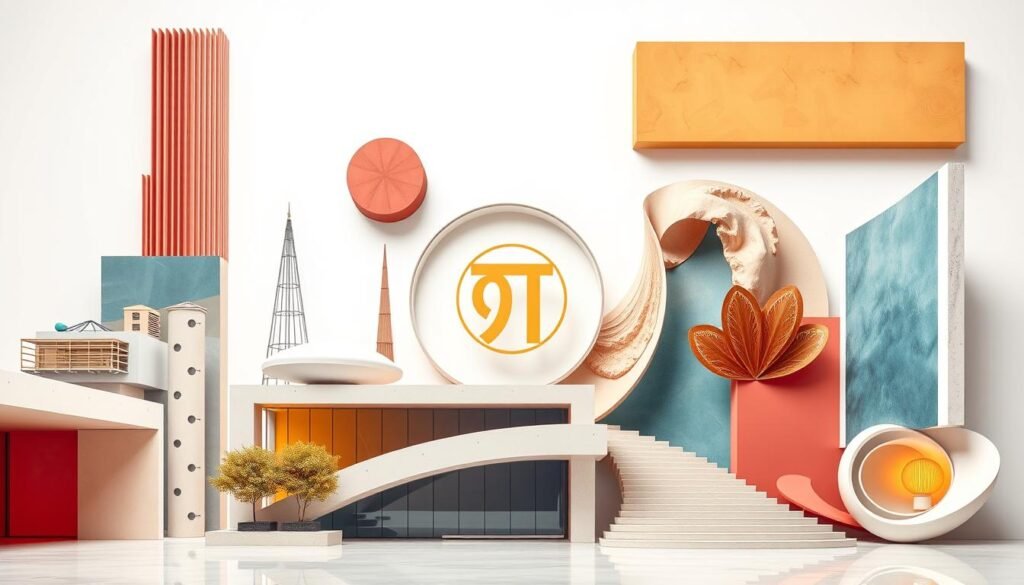What makes the golden ratio, about 1.618, so special in art, design, and math? It’s found in nature, art, and buildings. It’s believed to bring beauty and balance to designs. The golden ratio, or phi, is key in creating pleasing compositions.
The golden ratio has been around for over 2,300 years. Greek mathematicians first talked about it around 300 BC. It’s a ratio where a line is divided into two parts. The whole line divided by the longer part is the same as the longer part divided by the shorter part.
This ratio helps artists, designers, and architects make beautiful and balanced designs. These designs show the beauty of math and proportion in design.

Key Takeaways
- The golden ratio is about 1.618 and is key in beauty and harmony in art and design.
- The Fibonacci sequence is the base of the golden ratio, with each number being the sum of the two before it.
- The golden ratio helps make balanced and harmonious designs in art, design, and architecture.
- Using the golden ratio in designs creates a sense of balance and intention, drawing the viewer’s eye.
- Research shows that the human eye processes images with the golden ratio faster.
Understanding the Golden Ratio: A Mathematical Marvel
The Golden Ratio, often shown as the Greek letter phi (φ), is a key part of math and design. It has a value of about 1.618. This ratio is found in nature and art, making it key to good design.
The formula for the Golden Ratio is simple yet deep. It describes a line cut into two parts. The whole line divided by the longer part is equal to the longer part divided by the shorter part.
The Golden Ratio is linked to the Fibonacci sequence. This sequence is made by adding the last two numbers to get the next. As the sequence grows, the ratio of each number to the one before it gets closer to the Golden Ratio.
This connection shows how math and nature are linked. For over 4,000 years, artists and designers have used the Golden Ratio. Famous works like Leonardo Da Vinci’s “Mona Lisa” and “The Last Supper” show this.
What is Phi (φ)?
Phi, the Greek letter for the Golden Ratio, is an irrational number. It has fascinated mathematicians and designers for centuries. Its unique properties and appearances in nature and art make it a key part of math and design.
The Mathematical Formula Behind Beauty
The Golden Ratio’s formula, φ = (1 + √5)/2, defines this irrational number. This formula helps create beautiful designs, from leaf arrangements to galaxy structures. The Golden Ratio’s division property is key to these designs.
This property states that a line segment divided into two parts has a special ratio. The ratio of the whole segment to the longer part is the same as the ratio of the longer part to the shorter part.
Connection to the Fibonacci Sequence
The Fibonacci sequence is closely tied to the Golden Ratio. Each number in the sequence is the sum of the two before it. As the sequence grows, the ratio of each number to the one before it gets closer to the Golden Ratio.
This shows a deep connection between math and nature. This connection is seen in leaf arrangements, tree branches, and galaxy shapes.
The Historical Journey of Divine Proportion
The idea of divine proportion has shaped art, architecture, and design for ages. The golden mean, a key in geometry, helps make things look good. Artists, architects, and designers have used the golden ratio, about 1.618, for centuries.
Artists like Leonardo da Vinci and Salvador Dali used the golden ratio in their work. Their use of geometry and golden mean makes their art balanced and beautiful. Famous buildings, like the Parthenon in Athens, also show the golden ratio in their design.
The story of divine proportion shows how mathematical principles influence our view of beauty. As we delve deeper into the golden ratio in design, we see the role of geometry and mathematical principles. They help create art that is not just pleasing but also meaningful.
Nature’s Blueprint: Golden Ratio in the Natural World
The golden ratio is a key part of natural beauty. It shows up in flowers, seashells, and even our bodies. This design harmony brings balance and beauty to our view.
In nature, the golden ratio is seen in spiral patterns. This includes the leaves on a stem or the branches of trees. It’s also found in our bodies, like the ratio of arm to forearm and hand to fingers.
The golden ratio isn’t just for living things. It’s also in galaxies and natural events, like hurricanes or water flow. This shows the natural world’s beauty is built into its design.
| Example | Golden Ratio |
|---|---|
| Flower petals | 1.618 |
| Seashells | 1.618 |
| Human body proportions | 1.618 |
Using the golden ratio in design helps create balance and harmony. It makes things look more natural and beautiful. Designers use this principle to make their work more appealing and effective.
Sacred Geometry: Ancient Civilizations and the Golden Mean
The idea of sacred geometry has been around for ages. It helps create things that look good and feel right, using mathematical principles like the Golden Ratio. You can see this aesthetic balance in many architecture works, like the Great Pyramid of Giza and the Gothic cathedrals of Paris.
Here are some examples of sacred geometry in ancient times:
- The Golden Ratio in the Great Pyramid of Giza’s design
- Fibonacci sequence in Gothic cathedrals’ layout
- Using mathematical principles for balance in ancient art and architecture
In today’s world, sacred geometry is still important. It’s used in architecture and digital design. It brings harmony and aesthetic balance by applying mathematical principles and geometric shapes.
| Example | Description |
|---|---|
| Great Pyramid of Giza | Construction incorporates the Golden Ratio |
| Gothic Cathedrals | Design features Fibonacci sequence and sacred geometry |
| Modern Architecture | Application of mathematical principles and geometric patterns for aesthetic balance |
The Golden Ratio in Classical Art and Architecture
The golden ratio, also known as phi ratio, has been key in art and architecture for centuries. It’s seen in Leonardo da Vinci’s works and the Parthenon’s design. This ratio helps create balanced and harmonious pieces.
Here are some examples of the golden ratio in classical art and architecture:
- Leonardo da Vinci’s “Vitruvian Man” uses golden rectangles for the head, torso, and legs.
- The Parthenon’s facade follows the golden ratio, with many analyses showing it aligns with 1.618.
- The Great Mosque of Kairouan’s design is based on the golden ratio, seen in its layout and minaret.
The golden ratio has played a big role in creating iconic works. Artists and architects use it to achieve balance and harmony. This continues to inspire and amaze people today.

| Artist/Architect | Work | Golden Ratio Application |
|---|---|---|
| Leonardo da Vinci | Vitruvian Man | Multiple golden rectangles |
| Ictinus and Callicrates | Parthenon | Facade proportions |
| Unknown | Great Mosque of Kairouan | Layout, prayer area, court, and minaret |
Practical Applications in Modern Design
The design aesthetic of a composition greatly affects its appeal. By using the phi ratio, designers can make compositions balanced and harmonious. This is clear in architecture, where the golden ratio brings balance and stability.
In modern design, the phi ratio is used in many ways to make compositions visually appealing. For instance, designers can apply the golden ratio to decide on the size and placement of elements. This creates a balanced and engaging design aesthetic.
- Using the golden ratio to determine the size and placement of elements in a layout
- Creating a sense of balance and harmony in a composition
- Guiding the viewer’s eye through a design using the golden ratio
| Design Element | Golden Ratio Application |
|---|---|
| Layout | Using the golden ratio to determine the size and placement of elements |
| Composition | Creating a sense of balance and harmony |
| Visual Flow | Guiding the viewer’s eye through a design |
Digital Design and the Golden Ratio
The Golden Ratio in digital design makes things look balanced and beautiful. It helps create a aesthetic harmony in websites and apps. Designers use it to make layouts that catch the eye and make things easier to use.
In web design, the Golden Ratio helps place elements like buttons and images perfectly. It uses a ratio of 1:1.618 to make sure everything looks right. This makes the design look balanced and geometric proportion.
Brands like Pepsi, Apple, and Twitter have used the Golden Ratio in their logos. They’ve made their logos both eye-catching and memorable.
The Golden Ratio isn’t just for logos and web design. It’s also used to make user interfaces better. By using the Golden Ratio, designers can make things both pretty and useful. This leads to a more aesthetic harmony and design harmony.
| Design Element | Golden Ratio Application |
|---|---|
| Typography | Using the Golden Ratio to determine font sizes and line heights |
| Layout | Applying the Golden Ratio to determine the placement and size of elements |
| Logo Design | Incorporating the Golden Ratio to create visually appealing and memorable logos |
Photography and Composition Using Geometric Proportions
In photography, artistic composition is key to grabbing the viewer’s eye. The golden ratio, about 1.618, helps make images look balanced and pleasing. It helps photographers make pictures that move people and share messages well.
Photographers split the frame into thirds both ways to get 9 parts. Putting subjects at the lines’ cross points improves the image’s balance. The spiral pattern, made by squares in the Fibonacci sequence, also helps in creating balanced shots. This aesthetics in photography is based on geometric proportion. Famous photographers like Henri Cartier-Bresson and Richard Avedon show this well.
Some main photography composition rules include:
- Rule of thirds: Split the frame into thirds for balanced shots.
- Leading lines: Use lines to guide the viewer’s eye to the subject.
- Framing: Use natural or man-made things to frame the subject.
By using these rules and the golden ratio, photographers make images that are not just pretty but also balanced. Henri Cartier-Bresson said, “composition must be one of our constant preoccupations.” This shows how important geometric proportion is in photography.
| Photographer | Technique | Example |
|---|---|---|
| Henri Cartier-Bresson | Rule of thirds | “Behind the Gare Saint-Lazare” |
| Richard Avedon | Leading lines | “Dovima with Elephants” |

Common Misconceptions About the Golden Ratio
The Golden Ratio is a math concept about 1.618. It’s found in nature and used in art and design for ages. Yet, many people get it wrong or use it wrongly.
Some think the Golden Ratio is a magic trick for perfect art. Others say it’s just a myth. But, it’s a real math idea used in art and design.
Here are some common wrong ideas about the Golden Ratio:
- It’s a rule for all design.
- It makes everything beautiful.
- It’s only for art and design.
The Golden Ratio helps make designs look good, but it’s not for everything. It’s not a magic beauty maker. It’s a math tool for nice designs.
The Golden Ratio shows up in nature and is used in art and design. Knowing about it helps designers and artists make better work.
| Field | Application of Golden Ratio |
|---|---|
| Art History | Composition and design of paintings and sculptures |
| Architectural Design | Design of buildings and structures |
| Nature | Observation of mathematical ratio in natural patterns |
Conclusion: The Timeless Appeal of Mathematical Beauty
The golden ratio has moved beyond just math into art, architecture, and design. It has inspired many, from ancient wonders like the Taj Mahal to modern marvels like the iPhone. This principle of beauty and harmony is a key mathematical foundation. It creates visually stunning and pleasing compositions.
Learning about the golden ratio and its link to the Fibonacci sequence shows us the beauty in our world. We see it in nature’s spirals and in the design of our favorite designs. The golden ratio shows how art and mathematics work together. As we keep exploring and using it, we can create endless captivating works.
FAQ
What is the Golden Ratio?
The Golden Ratio, also known as the Divine Proportion, is a mathematical concept. It describes a ratio found in nature, art, and architecture. It’s the ratio of a line segment cut into two parts, where the whole divided by the long part equals the long part divided by the short part.
What is the mathematical formula behind the Golden Ratio?
The Golden Ratio’s formula is simple. It’s the ratio of a line segment cut into two parts. The whole length divided by the long part equals the long part divided by the short part. This ratio is represented by the Greek letter phi (φ) and is about 1.618.
How is the Golden Ratio related to the Fibonacci sequence?
The Golden Ratio is closely tied to the Fibonacci sequence. This sequence is a series of numbers where each number is the sum of the two before it. As the sequence grows, the ratio of any two consecutive numbers gets closer to the Golden Ratio.
How has the Golden Ratio been used in art and architecture throughout history?
Artists and architects have used the Golden Ratio for centuries. It helps create balanced and harmonious compositions. From Leonardo da Vinci’s works to the Parthenon’s design, it’s a key element in art and architecture.
Where can the Golden Ratio be observed in nature?
Nature shows the Golden Ratio in many ways. From flower spirals to seashell patterns, it’s a natural principle. It guides the growth and development of living things.
How has the Golden Ratio been used in sacred geometry?
Ancient civilizations used the Golden Ratio in sacred geometry. This system of geometric patterns was believed to have spiritual significance. It’s based on the idea that certain shapes have spiritual value and can create balanced compositions.
How can the Golden Ratio be applied in modern design?
Modern design uses the Golden Ratio to create balanced compositions. It’s applied in graphic and interior design to make designs visually appealing. The Golden Ratio helps create balance and adds drama to a design.
How can the Golden Ratio be used in digital design?
Digital design also benefits from the Golden Ratio. It’s used in web and logo design to create effective and appealing designs. The Golden Ratio helps optimize user interfaces and enhance the user experience.
How can the Golden Ratio be used in photography?
Photographers use the Golden Ratio to create balanced and engaging compositions. It helps capture the viewer’s attention and adds depth to a photo. The Golden Ratio is key to creating visually appealing and balanced images.
What are some common misconceptions about the Golden Ratio?
Many people misunderstand the Golden Ratio. Some think it’s a magical formula for perfect compositions. But it’s a real mathematical concept found in nature and used in art and design for centuries.
Source Links
- https://mightyfinedesign.co/golden-ratio-in-design/
- https://www.interaction-design.org/literature/topics/golden-ratio?srsltid=AfmBOopWPeerMWXCZFIVkaVUa-aVHHhld-sf5AXUnJsHOzNb48i4uhTa
- https://www.format.com/magazine/golden-ratio-in-design
- https://medium.com/@divashjyotik/golden-ratio-a-mathematical-marvel-ff073db925f6
- https://www.linkedin.com/pulse/marvel-golden-ratio-leslie-mupeti
- https://www.britannica.com/science/golden-ratio
- https://abakus-center.com/blog/the-golden-ratio-in-nature
- https://www.interaction-design.org/literature/topics/golden-ratio?srsltid=AfmBOoraTYW2ZsFs5nYyWlmeX8X7M6_xoGWj-129QzRqOMLXBYkeTgo3
- https://mathworld.wolfram.com/GoldenRatio.html
- https://medium.com/storyangles/sacred-geometry-from-golden-ratio-to-mandalas-bb904c3efbbd
- https://thehouseofaia.com/the-power-of-sacred-geometry-unlocking-hidden-patterns-in-nature-and-design/
- https://jwilson.coe.uga.edu/emt668/EMAT6680.2000/Obara/Emat6690/Golden Ratio/golden.html
- https://illustrarch.com/articles/13472-golden-ratio-in-architecture.html?srsltid=AfmBOorutxp1DGjZYSl55HSmV_Xps7EFio3spLs6XEbbwhK3hV-Ilo_4
- https://medium.com/thinking-design/the-golden-ratio-how-why-to-use-it-in-design-3ea6f943f8af
- https://www.interaction-design.org/literature/topics/golden-ratio?srsltid=AfmBOoq-Ys6V0QMMoQoIckktbdwpVwKMx5bnvGfa78EpvPMpPzLp_SrX
- https://illustrarch.com/articles/25236-using-golden-ratio-in-architecture.html?srsltid=AfmBOorjbx0N9uCC_Hna9aTYiLy72MD4Xsfwd4vNSajSvQOMY1p6OIir
- https://99designs.com/blog/tips/the-golden-ratio/
- https://www.creatopy.com/blog/golden-ratio-in-graphic-design/
- https://www.iphotography.com/blog/what-is-the-golden-ratio/
- https://www.apogeephoto.com/richard-avedon-henri-cartier-bresson-and-golden-ratio-compositions/
- https://en.wikipedia.org/wiki/Golden_ratio
- https://www.mathsisfun.com/numbers/golden-ratio.html
Click here to learn more about this topic in a related article.






Your article helped me a lot, is there any more related content? Thanks!